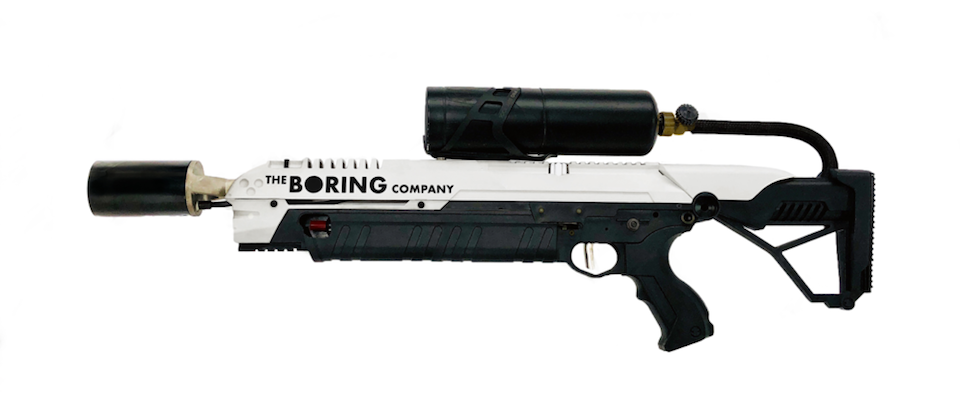Elon Musk has taken some heat over the past few months for selling flamethrowers through his firm, The Boring Company. The devices aren’t actual flamethrowers, though, hence their name: Not a Flamethrower. They’re more like hypertrophied blowtorches, perfect for caramelizing a crème brulee the size of a garbage can lid, perhaps, but thankfully unsuited for combat. Musk’s devices use propane and spout a three-to-four foot fixed flame. True military flamethrowers spew burning jellied gasoline up to 150 feet.
Nevertheless, stock quickly sold out on preorder. Assemblyman Miguel Santiago (D-Los Angeles), alarmed, drafted a bill to impose restrictions, stating that the publicity stunt was incredibly “…insensitive, dangerous, and most definitely not funny…” in the aftermath of California’s worst wildfire season.

But Santiago’s bill died in committee late last month, stymied by lobbying from the Firearms Policy Coalition, a gun rights advocacy group; Musk was able to begin shipping. Santiago’s bill, however, wouldn’t have done all that much. It wasn’t a ban—it merely subjected Musk’s torches to the same state restriction imposed on true flamethrowers, i.e., any device that can shoot flame more than ten feet. And meeting the terms of that restriction is hardly onerous: you just have to shell out $425 for a permit from the State Fire Marshal.
That’s right: real flamethrowers are legal in California, assuming an aspiring owner is willing to jump through a regulatory hoop. In fact, flamethrowers are completely legal in 48 states; only Maryland bans them outright, and California is the only other state that imposes even minimal impediments to ownership. And while it may be difficult (though not impossible) to find a military M2 flamethrower, the model used by U.S. troops from World War II through Vietnam, it’s easy to obtain civilian versions; that includes the XM42-M, a flamethrower produced by Ion Productions, which is touted as an ideal device for disposing of old Christmas trees.
Indeed, flamethrowers aren’t the only military-grade ordnance available to the hoi polloi. Federal law allows citizens to own fully automatic weapons. That means Uzis, AK-47s—even M-60 .30 caliber machine guns, the type that was standard issue in World War II. In fact, the list includes heavy machine guns— the behemoths that fire .50 caliber cartridges the size of baby zucchinis. There are some catches, of course. Under the 1934 National Firearms Act, the 1968 Gun Control Act and the 1986 Firearm Owners Protection Act, private citizens may own machine guns produced before 1986 by submitting photographs and fingerprints and agreeing to an exhaustive background check by the U.S. Bureau of Alcohol, Tobacco, and Firearms. The vetting can take more than a year, and the successful applicant must purchase a $200 “stamp” for each acquired weapon. Licensed gun dealers may also own automatic weapons, but again, the certification process is lengthy and burdensome. Generally speaking, it’s illegal to own any automatic weapons produced since 1986; some dealers may fabricate automatic firearms, but only for federal and state agencies under specific circumstances.
That’s a significant regulatory burden, but the fact remains that private American citizens can and do own machine guns, something that might properly alarm public safety advocates. And don’t forget those flamethrowers. So why isn’t more attention—even outrage—focused on them?
“They’re not worried about flamethrowers or machine guns…Police can see whether or not someone is carrying anything like that, and they can respond or plan accordingly.”
It’s likely due to simple street realities, observes Frank Zimring, a Berkeley Law professor, the faculty director for criminal justice studies at the school, and a widely recognized authority on violent crime and criminal sanctions. Flamethrowers and machine guns are indeed fearsome, acknowledges Zimring, but they are also unwieldy. Further, unlike semi-automatic weapons, they are rare, simply because there’s no legitimate use for them outside the military arena.
“If I’m running a police department, do I want fully automatic weapons in the hands of my officers?” Zimring asks rhetorically. “Clearly, the answer is no. In fact, the only reason that a person might want such weapons is to impress like-minded friends.”
Zimring notes that flamethrowers are not only limited by range and fuel, but are bulky and virtually impossible to conceal. True machine guns like the M-60 are also heavy, cumbersome and unsuited for rapid deployment; they also must be supplied from heavy cans of ammunition, another factor inhibiting their use in either street crime or terrorism. Further, Zimring notes, semi-automatic small arms fitted with so-called bump stocks can produce firing rates close to true automatic rates. Stephen Paddock, the retired tax auditor who killed 58 people and wounded more than 500 others in Las Vegas in 2017, used semi-automatic rifles and carbines fitted with bump stocks. The devices remain legal.
“One way of tracking the significance of these various weapons is to look at them from the perspective of law enforcement agencies, at what causes them the biggest concern,” Zimring says. “They’re not worried about flamethrowers or machine guns. And their biggest worry isn’t even semi-automatic rifles, even those with bump stocks. Police can see whether or not someone is carrying anything like that, and they can respond or plan accordingly. What causes them the greatest concern are handguns. There are so many of them, and they’re concealable. If you’re a cop—or even the owner of a liquor store—you’re going to be worried about semi-automatic pistols, not machine guns or AR-15s. Handguns are the reason why police in the U.S. are 25 times more likely to die than police in Germany or Britain. Handguns still account for most of the firearm-related deaths in this country. They’re the main issue.”





















